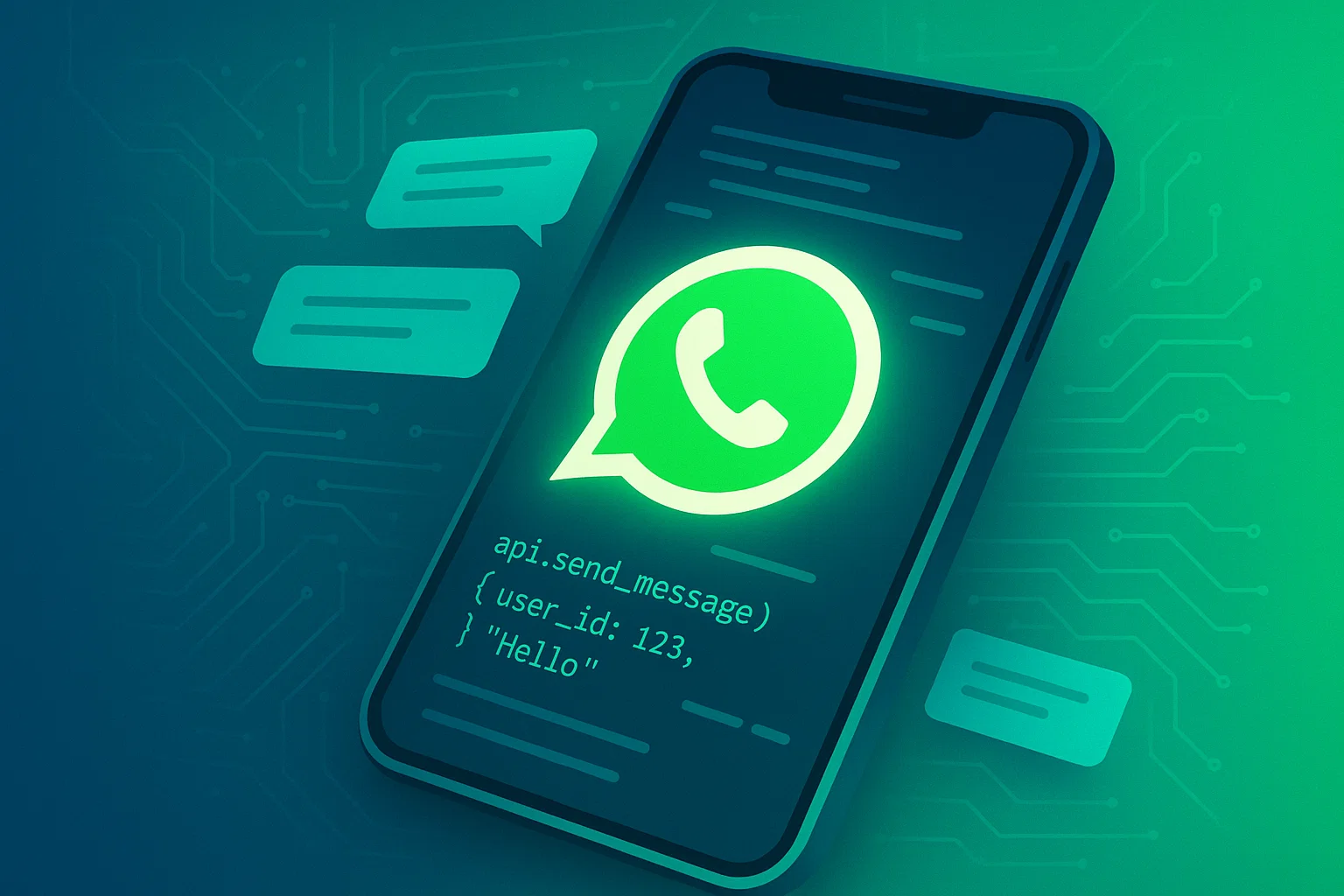WhatsApp API Business: The 2025 Guide to Customer Engagement
Imagine this: you’ve ordered something online—a pair of sneakers you’ve been eyeing for weeks. You pay, wait for confirmation, and… silence. Hours pass, you refresh your inbox, check your spam folder, nothing. Frustrated, you wonder if your order even went through.
Now, picture the same scenario, but instead, within seconds of checkout, you receive a WhatsApp message:
“Hi Alex, thanks for shopping with us! Your sneakers are confirmed and will be shipped tomorrow. Here’s your tracking link: [link].”
Feels better, right?
That’s the power of WhatsApp Business API—bridging the gap between businesses and customers in real time. With more than 2.7 billion active users globally, WhatsApp has quietly become not just a place to chat with friends but also a powerful business communication channel.
And here’s the kicker: people actually want to hear from businesses on WhatsApp. A recent survey found that over 75% of consumers prefer messaging a business over traditional channels like calls or emails [SOURCE NEEDED]. The WhatsApp API Business taps into this preference by enabling companies to automate responses, send timely updates, and even sell products—all without leaving the app customers already use daily.
In this deep-dive guide, we’ll cover everything you need to know about WhatsApp API: what it is, how it works, practical use cases, pricing, setup steps, and even some real-world case studies. Whether you’re a small startup or a global enterprise, this article will show you exactly how to unlock WhatsApp’s potential for your business in 2025.
Table of Contents
- What is WhatsApp API Business?
- Why WhatsApp API Matters in 2025
- How WhatsApp API Works
- Key Features of WhatsApp Business API
- WhatsApp API Use Cases
- Benefits of WhatsApp Business API
- WhatsApp API Pricing Explained
- Step-by-Step: How to Get Started with WhatsApp API
- Best Practices for Using WhatsApp API
- Case Studies & Real-World Examples
- FAQ: WhatsApp Business API
- Conclusion
What is WhatsApp API Business?
The WhatsApp Business API is not your typical “download-an-app-and-go” tool. Instead, think of it as a robust communication bridge between your business systems and WhatsApp’s massive user base.
Unlike the WhatsApp Business App, which is designed for small shops and solo entrepreneurs (think: local bakeries or small retailers), the API is built for scale. Medium to large businesses use it to handle thousands—even millions—of customer conversations seamlessly.
Here’s how it works in plain terms:
- It’s an Application Programming Interface (API), meaning it allows your systems (like CRM, chatbots, or support platforms) to “talk” to WhatsApp.
- Instead of manually sending messages from your phone, the API automates and integrates communication.
- You can send automated notifications (like flight delays, OTPs, appointment reminders) or even create two-way chats powered by human agents and AI bots.
WhatsApp API vs WhatsApp Business App
| Feature | WhatsApp Business App | WhatsApp Business API |
|---|---|---|
| Best for | Small businesses | Medium–large businesses |
| Setup | Mobile app | Through BSP or Meta Cloud API |
| Scalability | Limited | Unlimited conversations |
| Automation | Basic (quick replies) | Advanced (chatbots, CRM integration) |
| Multi-user support | No | Yes |
| Notifications | Limited | Automated + template-based |
In short: the app is for local shops, the API is for serious growth.
Why WhatsApp API Matters in 2025
So why is the WhatsApp Business API such a big deal right now? It boils down to one simple truth: customer expectations have changed.
We live in an instant world. No one wants to wait three days for an email reply. No one enjoys sitting on hold with customer service. People want answers now, on the apps they’re already using daily—and WhatsApp leads the pack.
Here’s why WhatsApp API matters more than ever in 2025:
- Massive Reach
WhatsApp has over 2.7 billion monthly active users, making it the world’s most popular messaging platform. That’s a market businesses simply can’t ignore. - Sky-High Engagement
WhatsApp messages enjoy a staggering 98% open rate, compared to just ~20% for email [SOURCE NEEDED]. If you want your customers to actually see your message, WhatsApp is the way to go. - Trust and Familiarity
Customers trust WhatsApp. Unlike SMS (which feels spammy) or email (which gets lost in promotions), WhatsApp feels personal and reliable. - Better Conversions
Businesses using WhatsApp report higher response rates, shorter sales cycles, and better customer retention. It’s not just communication—it’s revenue growth. - Shift Toward Conversational Commerce
Customers don’t want to visit websites, fill long forms, or download apps. They want to ask, buy, and pay—all within a chat. WhatsApp API enables exactly that.
Takeaway: In 2025, if you’re not on WhatsApp, you’re invisible to a huge chunk of your potential customers.
How WhatsApp API Works
The WhatsApp API doesn’t have a traditional interface like the app. Instead, it connects with your systems via backend integration.
Think of it like plumbing: you don’t see the pipes, but they deliver water exactly where you need it. Similarly, the API delivers messages between your business tools and your customers.
Official Providers vs Direct Access
You can’t just sign up for the API on your phone. Businesses have two options:
- Through WhatsApp Business Solution Providers (BSPs)
- Third-party companies authorized by Meta.
- They handle onboarding, compliance, and provide dashboards.
- Example BSPs: Twilio, 360dialog, WATI.
- Ideal for businesses that don’t have in-house developers.
- WhatsApp Cloud API (Meta’s own solution)
- Hosted directly by Meta.
- Faster setup, lower costs (no hosting fee).
- Ideal for developers who want direct integration.
WhatsApp Cloud API
Launched in 2022, the Cloud API makes it easier for businesses to start without complex server setups. With it, you get:
- Instant access via Meta’s developer tools.
- Pay-as-you-go pricing model.
- Secure, scalable infrastructure.
- No need to worry about server maintenance.
For most businesses in 2025, the Cloud API is the recommended route because it’s cheaper, faster, and more reliable than traditional BSP-hosted solutions.
Key Features of WhatsApp Business API
So, what makes the API worth all the hype? Here are its most powerful features:
- Two-way messaging: Customers can reach you, and you can reply instantly.
- Automated templates: Pre-approved templates for OTPs, alerts, and updates.
- Rich media support: Send images, PDFs, videos, catalogs, and more.
- Multi-agent support: Multiple team members can manage chats simultaneously.
- Chatbots & AI: Integrate bots for FAQs, bookings, or lead capture.
- Secure communication: End-to-end encryption keeps data safe.
- Analytics: Track delivery, read rates, and customer responses.
The API doesn’t just make messaging possible—it makes it powerful.
WhatsApp API Use Cases
Here’s where it gets exciting. Let’s look at how businesses actually use WhatsApp API:
Customer Support
No more waiting on hold for 45 minutes. Customers can just ping you on WhatsApp.
- Automate FAQs with a chatbot.
- Escalate complex queries to a live agent.
- Provide 24/7 support without hiring round-the-clock staff.
Example: A telecom company reduced call center load by 30% after shifting common queries (like data balance checks) to WhatsApp.
Order Updates and Notifications
Customers love real-time updates.
- Send order confirmations and receipts.
- Share delivery tracking links.
- Remind patients about upcoming doctor appointments.
[ADD HUMAN EXAMPLE]
Marketing and Promotions
Gone are the days of spammy SMS. With WhatsApp, promotions feel personal.
- Send personalized product recommendations.
- Offer time-limited discounts.
- Retarget abandoned carts.
Payments and Transactions
WhatsApp now supports in-app payments in some countries.
- Share secure payment links.
- Confirm transactions instantly.
- Enable “chat-based checkout.”
Example: A food delivery app boosted repeat orders by letting customers reorder directly from a WhatsApp message.
Benefits of WhatsApp Business API
Here’s why businesses swear by it:
- Scalability: Manage thousands of conversations seamlessly.
- Personalization: Tailor messages with customer data.
- Conversions: Chat-based sales close faster than emails.
- Customer satisfaction: Faster, more convenient service.
- Global reach: Expand across borders without SMS costs.
Simply put, the API combines reach, efficiency, and trust in one channel.
WhatsApp API Pricing Explained
Unlike SMS (per message), WhatsApp charges per conversation window.
- A conversation window = 24 hours of messaging with a customer.
- Two types:
- User-initiated (customer messages first).
- Business-initiated (you send the first message).
Pricing varies by country, usually $0.014 – $0.14 per conversation [SOURCE NEEDED].
Tip: The first 1,000 conversations per month are free, making it easier to test the waters.
Some BSPs add extra platform fees, so always check total costs.
Step-by-Step: How to Get Started with WhatsApp API
- Decide your method: Cloud API (faster, cheaper) or BSP (easier, managed).
- Verify your business in Meta Business Manager.
- Create a WhatsApp Business Account (WABA).
- Apply for API access (via BSP or Meta).
- Get a dedicated phone number for business use.
- Set up message templates (order updates, OTPs, alerts).
- Integrate with CRM/support tools.
- Test thoroughly before launching.
- Go live and monitor analytics.
It might sound technical, but with Cloud API, you can literally be live in a matter of days.
Best Practices for Using WhatsApp API
Here’s how to get the most out of it:
- Always get opt-in: Never spam. Customers must consent.
- Stay conversational: Write like a human, not a robot.
- Personalize messages: Use names, purchase history, preferences.
- Segment audiences: Don’t blast generic promos.
- Use templates smartly: Keep them friendly and relevant.
- Measure results: Track read rates, response times, and conversions.
Remember: WhatsApp is personal. Abuse it, and customers will block you.
Case Studies & Real-World Examples
- E-commerce brand: Increased sales by 25% using abandoned cart reminders.
- Healthcare provider: Reduced no-shows by 40% with appointment reminders.
- Banking sector: Improved fraud detection with instant WhatsApp OTPs.
- Travel company: Boosted bookings by sending flight deals directly on WhatsApp.
[ADD HUMAN EXAMPLE]
FAQ: WhatsApp Business API
1. What’s the difference between WhatsApp Business App and API?
The app is for small shops; the API is for medium/large businesses with automation needs.
2. Can I use WhatsApp API for free?
Only the first 1,000 conversations per month are free. After that, charges apply.
3. Do I need coding skills?
Not if you use a BSP. For Cloud API, yes—developers are required for integration.
4. Can I send bulk promotions?
Yes, but only to opted-in users and via pre-approved templates. Spamming risks account bans.
5. Is WhatsApp API secure?
Yes—end-to-end encryption ensures data privacy.
6. How long does setup take?
BSP: 1–2 weeks. Cloud API: a few days if verified.
Conclusion
The WhatsApp API Business is more than just a messaging tool—it’s a customer engagement powerhouse. In 2025, customers expect fast, personalized, and convenient communication, and WhatsApp delivers exactly that.
Here’s the bottom line:
- Your customers are already on WhatsApp.
- They want to hear from you there.
- The API lets you meet them where they are—at scale.
Whether you’re in e-commerce, healthcare, banking, or hospitality, the WhatsApp Business API can transform the way you connect with your customers. Start small with order notifications or support, then scale to full conversational commerce.
The future of business communication is already here—it’s happening on WhatsApp. The question is: will your business be part of it?




